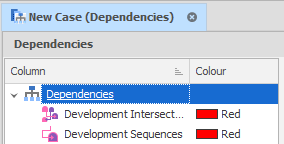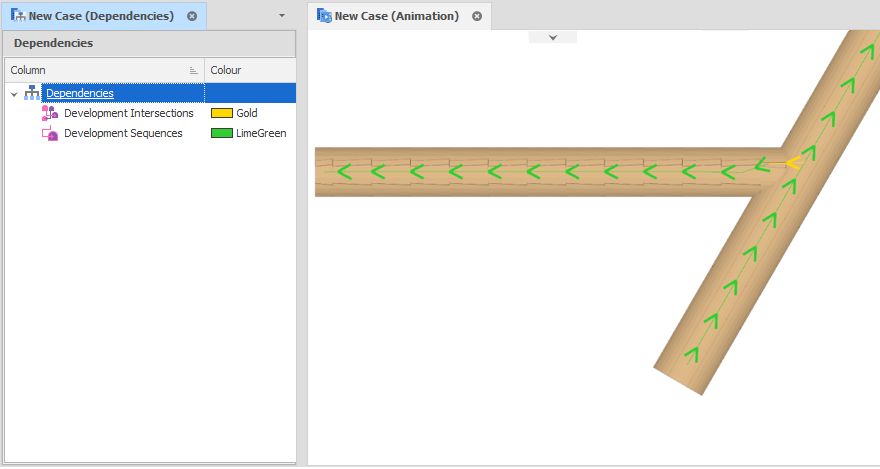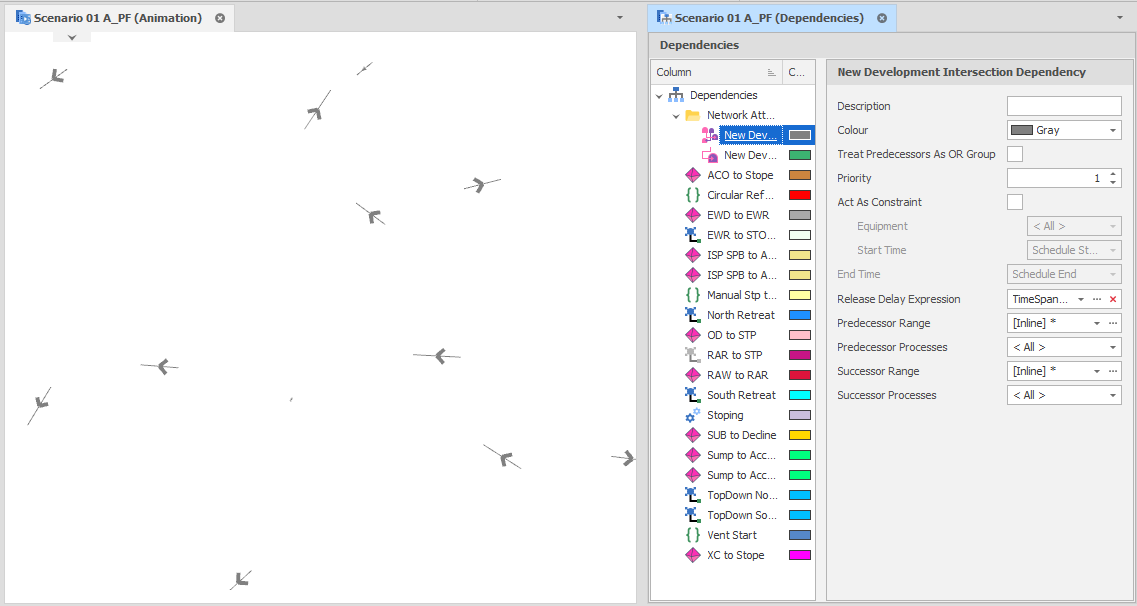Development Intersection Dependencies
When you create a new case in the Project Explorer, Development Intersection and Development Sequence dependencies are generated. Sequence dependencies are generated from all internal dependencies in the Development Network Layer, based on their Cut, and are case-specific. Similarly, intersection dependencies are generated from the intersections in the Development Network Layer.
Development Sequence and Intersection dependencies can be renamed, removed or new Development Sequence and Intersection dependencies can be added to the case.

If we add data to a case and create the bare minimum schedule we can see how these dependencies interact. Firstly, if we change the Intersection Dependency to Gold and the Sequence dependency to LimeGreen, we will be able to see the dependencies in the Animation Window using Dependencies > Overlay > Annotate Dependencies.
We can see here that the green arrows represent the direction of mining of two tunnels based on the Sequence dependency and the Yellow arrow represents the intersection between the two tunnels. This scenario would result in the right tunnel being mined up until the yellow arrow, then both tunnels being mined after that.

Here is an animated example:
Add
Development Intersection dependencies are generated from the intersections of internal dependencies in the Development Network Layer and are case-specific.
To view dependencies in the Animation Window, enable Annotate Dependencies and then select the Development Intersection Dependency from the Annotate Dependencies > Network Attach > right-click menu.
When you add or edit a Dependency of this type, you can set the following parameters (or accept the defaults where applicable):
![]()
Description
Optionally, enter a Description that can be used with the Name to further identify the Dependency. Detail useful for diagnosing issues with Dependencies should be added here.
Colour
Use the drop-down to differentiate this type of dependency by colour in the Animation Window.
Treat Predecessors as OR Group
Where multiple predecessor tasks have the same successor task and the OR check box is NOT enabled, the successor task will only be released after ALL of the predecessor tasks are completed.
Where multiple predecessor tasks have the same successor task and the OR check box is enabled, then the successor task will be released when ANY of the predecessor tasks are completed.
Priority
The Priority is a numerical method to classify your dependencies by importance. Ranges with Priority 1 will be resolved first, meaning if there are conflicting dependencies between two or more ranges, ranges with lower priority will become circular, rather than randomly resolving the conflict.
Act As Constraint
Normally a Dependency takes into consideration the relationship between Tasks regardless of the Equipment or Date involved. Selecting the Act As Constraint check box
For example, if the user ticks act as constraint in the dependency range, and excludes Jumbos, the Jumbos will not honour the dependency range.
Set the Source (Text Range or [Inline] *) Range that applies to the Tasks. See: Text Range and Inline Ranges.
Release Delay Expression
Once a Predecessor Range has been completed, the Release Delay controls how long until the Successor Range is considered "Released" and can be worked. Accept the default (None) or build a Release Delay Expression using the operators, constants and functions provided by the Expression Editor.
A common user case example is to use release delays between paste filling (for example, 21 days) and subsequent adjacent drilling or bogging activity.
Predecessor/Successor Range
By default, the predecessor and successor range for the Development Intersection dependency is set to everything ([Inline]*). This ensures that all the generated development solids intersections from the Development Network Layer are connected based on their cut and direction.
There are instances where the user might want to exclude certain development type out of the automated intersections. An example is excluding vertical development out of the intersection dependency. Instead, the user might want to create their own geometric dependencies to connect horizontal to vertical development to ensure their predecessor and successors are sequenced according to site restrictions.

Development Intersection Dependencies
Predecessor/Successor Processes
Allows you to control which Processes are used for the Dependency.